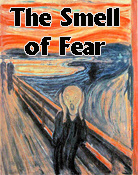 American military researchers are working to uncover and harness the most terrifying chemical imaginable: that most primal odor, the scent of fear.
American military researchers are working to uncover and harness the most terrifying chemical imaginable: that most primal odor, the scent of fear.
by David Hambling
Pheromones are chemicals released by animals as signals to their own kind: for sex, for territorial marking, and more. They’re often detected in the olfactory membranes. But there’s more to pheromones than attraction. Many animals have an alarm pheromone which is used to signal danger; aphids, for example, use it to cause their fellow lice to flee.
Now, the US Army is trying to track down and harness people’s smell of fear. The military has backed a study on the "Identification and Isolation of Human Alarm Pheromones," which "focused on the Preliminary Identification of Steroids of Interest in Human Fear Sweat." The so-called "skydiving protocol" was the researchers’ method of choice…
The authors collected sweat, urine, blood, saliva, ECG, respiration, and self-report measures in 20 subjects (n=11 males and n=9 females) before, during, and immediately following their first-time tandem skydive, as well as before, during, and immediately following their running on a treadmill for the same period of time. Measurements between the test (skydive) and control (exercise) conditions were made on consecutive days, each experiment precisely matched to the minute between subjects and between conditions to prevent diurnal confounds. Emotional states were monitored using brief standardized questionnaires. For most of the observed compounds, men showed an increase in the compound emission during acute emotional stress, while women showed either no change or a decrease in emission of the compound…
In a lecture given at a 2007 Congress on Stress, the researchers hint at what their study found:
Our findings indicate that there may be a hidden biological component to human social dynamics, in which emotional stress is, quite literally, “contagious."
This work piggybacks on a 2002 study by the Ludwig-Boltzmann-Institute for Urban Ethology at the University of Vienna. Subjects wore underarm pads while watching a ‘terrifying’ film — the horror movie Candyman — or a ‘neutral’ documentary. Afterwards subjects were asked to try and distinguish between pads worn by people seeing each film. The results showed that they could -– though subjects thought the smell was aggression rather than fear.
Some have suggested that the human alarm pheromone could lead to chemical fear-sensors. The project Integrated System for Emotional State Recognition for the Enhancement of Human Performance and Detection of Criminal Intent (do they call it ISESREHPDCI for short?) specifically mentions the possibility of monitoring pheromone levels:
Such systems could be used to assess fitness for duty, integrated into closed loop systems regulating user vigilance and workload, or used to detect the sinister intent of individuals and prompt pre-emptive interdictions. These systems could unobtrusively monitor individuals within military operational environments or crowded civilian settings by relying on passive detection.
If they’re trying to spot terrorists at an airport, it may not work: I know a number of people whose fear levels when approaching a flight would overload any fear sensor for miles. The suicide bombers are probably way calmer.
But what about offensive use? Pheromones are effective in minute quantities, so a wide area can be blanketed with just a few liters. Given sufficient concentration, would everyone exposed start suffering from an unidentifiable dread? The contagious aspect means that those affected would start churning out fear pheromone as well.
On its own, the alarm pheromone probably would not do much. But given an external trigger, such as a loud noise, it could influence people to start stampeding like spooked cattle. Then again, the bee alarm pheromone triggers attack rather than flight, and the Viennese study suggested something similar may apply to humans — or are there multiple pheromones involved? Whatever is going on, this research is likely to uncover some novel and powerful ways of manipulating human behavior.
Some in the military research complex have been down this road before. Remember the so-called "Gay Bomb," that would make enemy combatants irresistibly attracted to one another? Speaking of which, all those web sites advertising pheromones to make you irresistible to the opposite sex haven’t actually got many decent studies to back them up, a topic I explored in last month’s Fortean Times magazine.
"Go to Original" links are provided as a convenience to our readers and allow for verification of authenticity. However, as originating pages are often updated by their originating host sites, the versions posted on VT may not match the versions our readers view when clicking the "Go to Original" links.
(In accordance with Title 17 U.S.C. Section 107, this material is distributed without profit to those who have expressed a prior interest in receiving the included information for research and educational purposes. VT has no affiliation whatsoever with the originator of this article nor is VT endorsed or sponsored by the originator. Any opinions expressed by the author(s) are not necessarily those of VT or representative of any staff member at VT.)
ATTENTION READERS
We See The World From All Sides and Want YOU To Be Fully InformedIn fact, intentional disinformation is a disgraceful scourge in media today. So to assuage any possible errant incorrect information posted herein, we strongly encourage you to seek corroboration from other non-VT sources before forming an educated opinion.
About VT - Policies & Disclosures - Comment Policy




